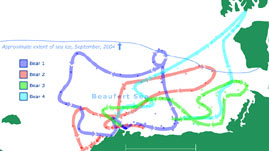Teachers' Domain - Digital Media for the Classroom and Professional Development
User: Preview

Source: USGS: Alaska Science Center



In this interactive activity adapted from the USGS Alaska Science Center, investigate the migration patterns of polar pears. Radio and satellite data show changes in the extent of Arctic sea ice during the year and the corresponding movements of a polar bear. In addition, compare the paths taken by four polar bears during the same year.
Polar bears are well adapted to life in the cold Arctic environment. Their thick fur and blubber keep them so well insulated that it is actually easy for them to overheat. They also have large paws that help them move around on the snow and sea ice, where they hunt, breed, and den. Similar to how snowshoes allow people to walk across snow without sinking, the large size of the paws helps distribute the bears' weight over a larger surface area. Small bumps covering the pads of their feet and hair between the pads increase traction and help prevent polar bears from slipping on ice. They also have claws, which they use when running or climbing on ice and for gripping prey. In addition, they use their paws as paddles in the water.
Polar bears primarily eat seals, although they may also hunt young walruses and beluga whales, and occasionally eat other foods such as reindeer, rodents, birds, vegetation, or garbage. Most commonly, polar bears hunt seals by waiting motionless near a break in the sea ice. When a seal surfaces for air, the bear flips it out of the water in one swift move. Polar bears also hunt seals by stalking them: when a seal leaves the water and moves onto the ice, the bear slowly follows, then suddenly charges and grabs the seal before it has a chance to escape back into the water. Some polar bears, usually mothers with young cubs, may also hunt seal birth lairs—caves built in snowdrifts where female seals nurse their pups. When the bear smells or hears something inside the birth lair, it pounces on the snow and crashes through the roof.
Because polar bears use sea ice as a platform from which to hunt seals, they must migrate according to changes in sea ice during the year and follow the availability of their prey. In the winter, when there is more sea ice, they move farther south; as the ice melts, they move farther north. As a result, polar bears can have large territories—one bear was tracked as it traveled 3,000 miles over the course of a year (although some bears may have smaller home territories). During the ice-free season when they are on land, polar bears fast for up to four months and rely on their stores of fat for energy.
Scientists track the movements of polar bears by harmlessly tagging them with radio transmitters, which send signals via satellite to gather data about their location. By learning how the bears utilize their habitat, scientists can gain a better understanding of how they will be affected by changes to their environment, such as the reduction of sea ice, caused by global warming.
 Loading Standards
Loading Standards Teachers' Domain is proud to be a Pathways portal to the National Science Digital Library.
Teachers' Domain is proud to be a Pathways portal to the National Science Digital Library.
